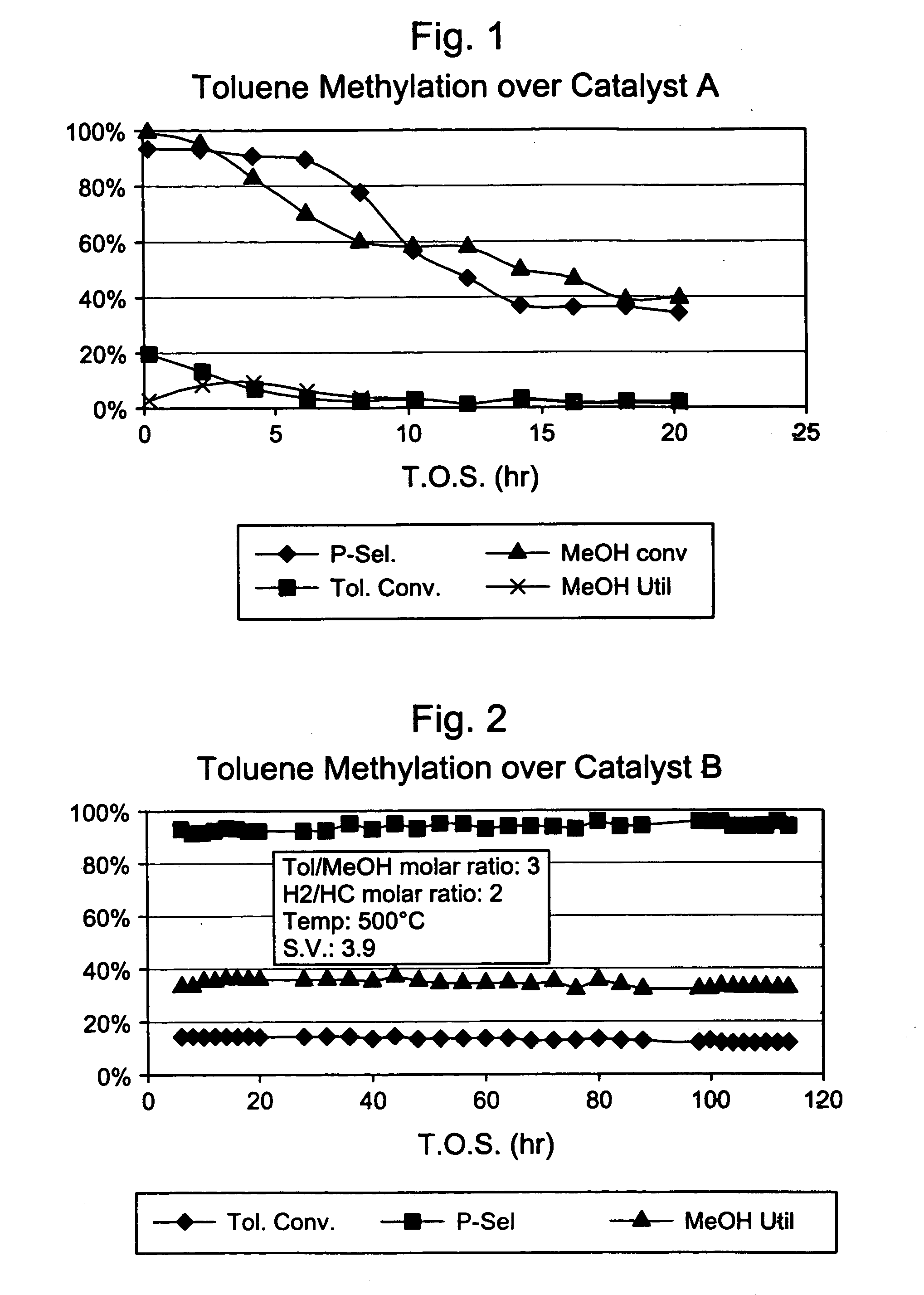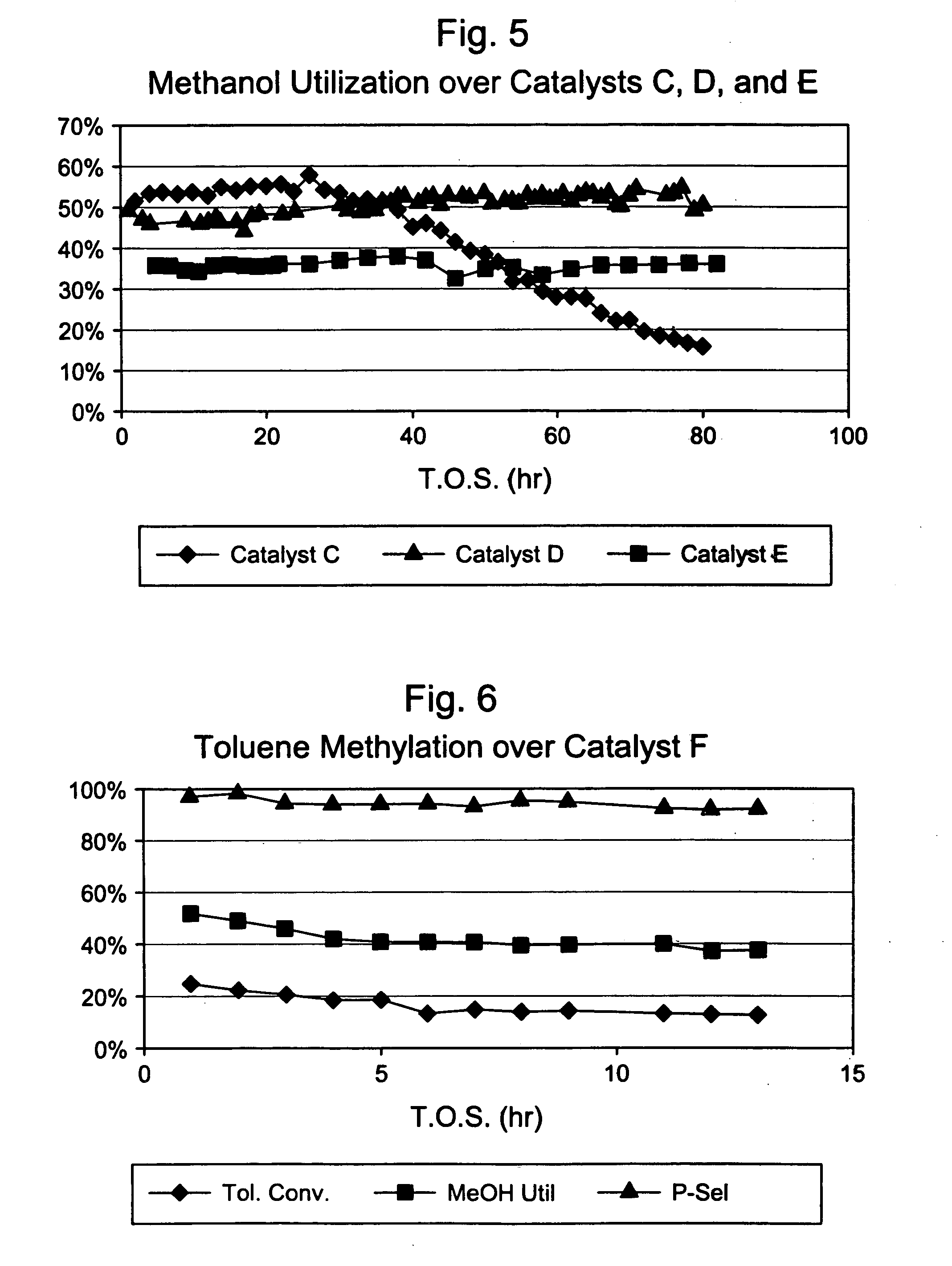Process for aromatic alkylation
a selective alkylation and aromatic alkylation technology, applied in the direction of physical/chemical process catalysts, organic compound/hydride/coordination complex catalysts, bulk chemical production, etc., can solve the problem of large quantities of benzene, high separation cost of para-xylene from the other isomers, and low selectivity of methanol to para-xylene, the desirable product, etc. problem
- Summary
- Abstract
- Description
- Claims
- Application Information
AI Technical Summary
Benefits of technology
Problems solved by technology
Method used
Image
Examples
example 1
4× Silica-Selectivated, 0.1 % Pt impregnated H-ZSM-5 / SiO2 (Catalyst A)
[0029] Silica-bound H-ZSM-5 (0.4 μm, 26:1 Si:Al2) extrudate (65 / 35 ZSM-5 / SiO2, {fraction (1 / 16)}″ cylindrical) was impregnated for 0.1 wt. % platinum (Pt) with tetraammine platinum nitrate and calcined at 660° F. This material was then selectivated with silica by impregnating with 7.8 wt. % Dow™-550 silicone (dimethylphenylmethylpolysiloxane) in decane, stripping the decane, and calcining at 1000° F. This silica selectivation procedure was repeated three more times. The final material had an alpha value of 255.
example 2
Steamed, 4× Silica-Selectivated, 0.1% Pt impregnated H-ZSM-5 / SiO2 (Catalyst B)
[0030] Silica-bound H-ZSM-5 (0.4 μm, 26:1 Si:Al2) extrudate (65 / 35 ZSM-5 / SiO2, {fraction (1 / 16)}″ cylindrical) was loaded with 0.1 wt. % Pt by incipient wetness impregnation with tetraammine platinum nitrate, followed by drying at 250° F. and calcining for 1 hour in air at 660° F. The platinum-containing extrudate was then selectivated with silica by impregnating with 7.8 wt. % Dow™-550 silicone in decane, stripping the decane, and calcining. This procedure was repeated three more times. The 4× selectivated material was then steamed in 100% steam at atmospheric pressure for 24 hours at 1000° F. The final material had an alpha value of 17.
example 3
Steamed, 3× Silica-Selectivated H-ZSM-5 / SiO2 (Catalyst C)
[0031] Silica-bound B-ZSM-5 (0.4 μm, 26:1 Si:Al2) extrudate (65 / 35 ZSM-5 / SiO2, {fraction (1 / 16)}″ cylindrical) was selectivated with silica by impregnating with 7.8 wt. % Dow™-550 silicone in decane, stripping the decane, and calcining at 1000° F. This procedure was repeated two more times. The 3× selectivated material was then steamed in 100% steam at atmospheric pressure for 24 hours at 1000° F. The final material had an alpha value of 15.
PUM
| Property | Measurement | Unit |
|---|---|---|
| pressure | aaaaa | aaaaa |
| temperature | aaaaa | aaaaa |
| partial pressure | aaaaa | aaaaa |
Abstract
Description
Claims
Application Information
 Login to View More
Login to View More - R&D
- Intellectual Property
- Life Sciences
- Materials
- Tech Scout
- Unparalleled Data Quality
- Higher Quality Content
- 60% Fewer Hallucinations
Browse by: Latest US Patents, China's latest patents, Technical Efficacy Thesaurus, Application Domain, Technology Topic, Popular Technical Reports.
© 2025 PatSnap. All rights reserved.Legal|Privacy policy|Modern Slavery Act Transparency Statement|Sitemap|About US| Contact US: help@patsnap.com



